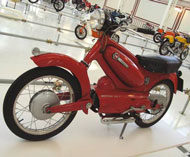
MOTOM 98T
You can beam this one up, Scotty
Born in the same year as I, Motom didn’t prove to be quite as resilient. It died in the early 1960s, but then again there was a pretty good chance that I was going to go round about then myself. The combination of a CB72 Honda and a somewhat … irregular lifestyle was not what you’d call auspicious.
One other major difference between me and the Italian marque with which I share a birthday is that Motoms were really good-looking. Weird, with their pressed-steel frames and futuristic-looking enclosures around the engine, but good.
This particular motorcycle, which was designed by the famous engineer Piero Remor, still amazes people. The description below comes mainly from sources at the CMM Collezione Motociclistica Milanese, which is where the bike is. The photos are from CMM’s MAD exhibition in Milan in 2007.
“The aesthetics are incredibly innovative and very distinct from any other previous model. The line is characterised by a centrally positioned oval outline, which appears initially to be the fuel tank, but in reality the fuel is only present in the left side, as the right side serves as a storage area for tools (complete with a fuel cap).
“On both sides of the 98T there is an identical circular opening with slits: one is the horn and the other is the vent for the air filter. If the Motom amazes people for its aesthetics, the mechanical features are no less surprising. The front suspension, for example, is of the swinging arm variety and also includes the mudguard. As far as the damping element is concerned, the far more original rubber discs that work through torsion replace the traditional springs.
“The engine, hidden beneath the central tunnel, is a four-stroke single-cylinder. The public was both intrigued and confused by these futuristic features and the 98T was not successful commercially and was only produced for a few years.”
A total of only 1736 of these little 98cc gems were built and wouldn’t you like one today?
“Years later, it was to be vindicated when it was chosen as an exhibit in the temple of art: New York’s Museum Of Modern Art.”
Motom produced a bewildering variety of small motorcycles, ranging from 48cc up to 163cc in the popular Delfino. It was one of Italy’s most prolific producers half a century ago, although the company was little known elsewhere. It also racked up countless successes with its 50cc production racers. In Italy, Motom became the third-biggest producer of motorcycles in the mid-1950s, after only Moto Guzzi and Garelli.
Initially, Motom’s success was led by the 50cc Motomic, despite early problems with reliability. In 1953, the company temporarily recruited Piero Remor; styling and mechanical details were revised to make the little bike more purposeful. While the engine still only had 48cc, it put out more than two horsepower, the sort of performance you would have expected from a much larger engine. The Motomic’s engine was easily tuned to give even more power and was soon being raced. In 1953, it averaged almost 40mph as it covered nearly 2000 miles in a week and spectacularly won its class in the Giro d’Italia.
Despite the Motomic’s victories (and many other models — Motom also built bikes with automatic gearboxes and even motocross machines), the bike the marque is best remembered for is the memorable 98T.
Piero Remor deserves to be better known. He designed the famous four-cylinder dual overhead cam Gilera racing motor and was a mentor for the famous Arturo Magni, who began his distinguished career in the Gilera racing division in 1947 under Remor’s guidance. In 1950, when Arturo Magni was poached for the newly formed MV Agusta racing division, he took Remor with him. Magni was the chief mechanic and Remor was chief designer, and the team they built went on to win no fewer than 37 world championships between 1952 and 1974 for MV. Mind you, a lot of Remor’s more exotic ideas (such as shaft drive — on a racing bike!) were discarded bit by bit as the racing MVs became more competitive.
Specifications
Engine: 98cc single horizontal cylinder with chain-driven overhead camshaft
Output: 6.75bhp @ 8200rpm
Compression ratio: 7.65:1
Lubrication: oil sump integral with engine
Carburettor: Weber
Ignition: coil ignition from points at end of camshaft, automatic advance/retard
Gearbox: four-speed in unit with engine
Transmission: gear primary drive
Suspension: swinging forks front and rear, controlled by rubber in torsion
Tyres: 250×17 front and rear
Brakes: sls drums, 7in front, 5.5in rear
Tank capacity: 1.5 gallons
Seat height: 29in
Top speed: 60mph approx
Fuel consumption: 110mpg claimed
